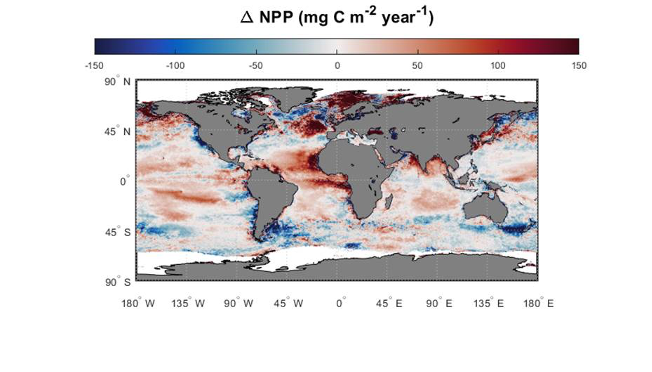Ocean Net Primary production
Short description
Ocean ColourOur planet is constantly changing. Some changes are fast – such as seasons and phytoplankton blooms – while others are slow and occur over decades to millennia. Some changes are caused by natural phenomena, while others, including global warming and ocean acidification, are caused by human activity. To see changes beyond the normal seasonal variability that is caused by our planet’s weather patterns, it is necessary to collect data over long periods of time. We have been using satellite sensors to collect such data and to observe our planet from space for more than two decades.One of the most important processes in nature is primary production, which occurs when plants take up carbon dioxide (CO2) from the atmosphere or the ocean and use the energy from the sun to fix the carbon that is necessary for their growth. Primary productivity is at the base of our food chain and key to all life on Earth. In the oceans, microscopic plants called phytoplankton are responsible for the majority of primary production.Many things affect primary productivity, including sunlight, CO2, and nutrients, which are the essential ingredients for photosynthesis and growth. In the oceans, phytoplankton primary productivity is mostly controlled by the amount of sunlight and the availability of nutrients. Using satellite observations, we have measured how ocean primary productivity – which produces oxygen for us to breathe, supports marine food webs, and helps to store atmospheric CO2 in the deep ocean – has changed over the past 25 years.Even with this long record, it is difficult to disentangle natural drivers of change from those induced by humans, such as climate change. Why is this so hard? The ocean and the atmosphere are connected, and some of the natural changes take place over decades. For example, the Atlantic Multidecadal Oscillation (AMO) – which causes cool and warm fluctuations in sea surface temperature (SST) – may last for 20-40 years. The El Niño-Southern Oscillation (ENSO), a major phenomenon that causes warming in the equatorial Pacific Ocean, can be as frequent as every 3 years, with variable intensity. These natural changes, or oscillations, affect SST, precipitation, and wind patterns, leading to changes in the water column conditions on which phytoplankton and primary production depend. Human activities, especially the increase of CO2 in the atmosphere due to the burning of fossil fuels, have also impacted global temperatures and water column conditions, which in turn impact ocean primary production.Our ocean is vast and complex, which results in regional differences in primary production. For example, in coastal areas, particularly those close to rivers, primary productivion is higher due to the runoff of nutrients from land. The western coasts of the continents, where wind and topography bring nutrient-rich deep water to the surface (i.e. upwelling), also show high primary productivity. These areas are important for fisheries, particularly in South America. In contrast, in large areas of swirling ocean currents, known as gyres (Fig. 1), primary production is low and these regions are considered ocean deserts. A 16-year (1998-2013) analysis of trends in the five subtropical ocean gyres revealed warming and expansion of these ocean deserts, which means a decrease for the ability of our ocean to absorb CO2 from the atmosphere (Signorini et al. 2015, Leonelli et al, 2022).Layer ID: ID: BICEP_NPP_VIS_PP2 collectionID: a216afca-8a65-4072-87a5-8ed7aa21e08a from 1998 - 2020Band information
The product contains one single band named "pp".More information

Changes in primary production based on the VGPM Model (Behrenfeld and Falkowski, 1997) over the period 1998-2022. Red colors indicate increases, while bluish colors indicate decreases. Seasonally ice covered areas, like the poles, are not included in this analysis and are shown in white.